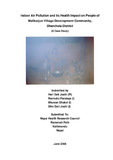Please use this identifier to cite or link to this item:
https://hdl.handle.net/20.500.14356/328Full metadata record
| DC Field | Value | Language |
|---|---|---|
| dc.contributor.author | Adhikari, Shyam Prasad | |
| dc.contributor.author | Chhetri, Madhu Kumar Khadaka | |
| dc.date.accessioned | 2012-12-31T22:46:16Z | |
| dc.date.accessioned | 2022-11-08T10:14:22Z | - |
| dc.date.available | 2012-12-31T22:46:16Z | |
| dc.date.available | 2022-11-08T10:14:22Z | - |
| dc.date.issued | 2008 | |
| dc.identifier.uri | http://103.69.126.140:8080/handle/20.500.14356/328 | - |
| dc.description.abstract | Executive Summary Indoor air pollution in Nepal is causing deleterious effects for its people, living in the rural households, who have to depend on the low quality of energies. Kitchen pollution, in these households, is so high that the frequencies of respiratory diseases are prevalent. With this condition, it is of no surprise that, Acute Respiratory Infection (ARI), in Nepal, is the second leading morbidity in 2006/2007. This study carried out in Malikarjun VDC of Darchula District is intended to link the kitchen characteristics and exposure duration of locals (especially children and their mother) with the disease prevalence. This kind of study is itself first of its own in the VDC and will be highly relevant in finding out the situation of the rural village. This study was a field-oriented program, which was supported by medical check up, measurement of kitchen characteristics and households survey, Measurement of Respiratory Functions, Episode identification of Acute Respiratory Infection in children below two years of age, Informal discussion and Key Informants. The result confirmed that, exposure duration, smoking habit and indoor environment of the households are causing different types of diseases in the VDC including respiratory disorders in the adults and prevalence of ARI in the children up to two years of age. Further, it was found that the use of clean energy was minimal in the households and all kitchens were characterized by the presence of smoke because of the use of low quality energy sources including fuel wood and the lack of proper ventilation system. In addition, the area of the kitchen and doors in them were not up to the recommended level. In conclusion, the study was able to determine that the prevalence of diseases in the households in the rural Malikarjun VDC of Darchula District was the result of indoor air pollution initiated by the use of low quality energy and poor kitchen characteristics. Thus, this study recommends for promoting the efficient energy systems in the households as well as remanufacturing of the kitchen and the building with proper ventilation. | en_US |
| dc.description.sponsorship | Nepal Health Research Council | en_US |
| dc.language.iso | en_US | en_US |
| dc.publisher | Nepal Health Research Council | en_US |
| dc.subject | Arsenicosis | en_US |
| dc.title | Prevalence Survey of Arsenicosis in Kailali and Bardiya Districts of Nepal | en_US |
| dc.type | Technical Report | en_US |
| Appears in Collections: | Post Graduate Grant (PG) Reports | |
Items in DSpace are protected by copyright, with all rights reserved, unless otherwise indicated.

